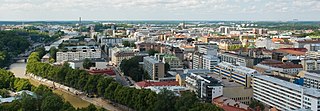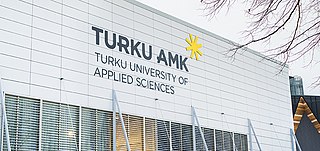Related Research Articles

Turku is a city and former capital on the southwestern coast of Finland at the mouth of the River Aura, in the region of Southwest Finland (Varsinais-Suomi) and the former Turku and Pori Province. The region was originally called Suomi (Finland), which later became the name of the whole country. The population of Turku is 201,085 making it the sixth largest city in Finland. The Turku region has a population of 345,522, making it the third largest urban area in Finland after the Helsinki and Tampere regions. The city is officially bilingual, with 5.5 per cent of the population having Swedish as their mother tongue.

The University of Helsinki is a public research university located in Helsinki, Finland, since 1829, but founded in the city of Turku in 1640 as the Royal Academy of Åbo, at that time part of the Swedish Empire. It is the oldest and largest university in Finland with the widest range of disciplines available. In 2020, around 31,600 students were enrolled in the degree programs of the university spread across 11 faculties and 11 research institutes.

The University of Turku, located in Turku in southwestern Finland, is the third largest university in the country as measured by student enrollment, after the University of Helsinki and Tampere University. It is a multidisciplinary university with eight faculties. It was established in 1920 and also has facilities at Rauma, Pori, Kevo and Seili. The university is a member of the Coimbra Group and the European Campus of City-Universities (EC2U).
The National Union of University Students in Finland is the largest national organisation providing benefits and services for students in Finland. Its members, including student unions and one student body, consists of over 140,000 bachelor's and master's degree students as well as postgraduates. It was established in 1921.

Aalto University is a public research university located in Espoo, Finland. It was established in 2010 as a merger of three major Finnish universities: the Helsinki University of Technology, the Helsinki School of Economics and the University of Art and Design Helsinki. The close collaboration between the scientific, business and arts communities is intended to foster multi-disciplinary education and research.
In Finland the higher education system comprises two parallel sectors: universities and universities of applied sciences (polytechnics). Universities are characterised by scientific research and the highest education based thereon. Universities of applied sciences are oriented towards working life and base their operations on the high vocational skill requirements set by it.

The Student Union of the University of Helsinki was founded in 1868. It currently has 32,000 members and is one of the world's richest student organizations, with assets of several hundred million euros. Among other things, it owns a good deal of property in the city centre of Helsinki.

Iso-Heikkilä Observatory is an amateur astronomical observatory used by a local amateur astronomical association, Turun Ursa ry in the Iso-Heikkilä district of Turku, Finland.

Lilja is a red granite sculpture by Wäinö Aaltonen, located in Turku, Finland. It is located in Runeberginpuisto near the Aurasilta. It depicts the lily, the flower of the Turku coat of arms. In 1927, the statue was the first public art commission in Turku.

In Finland, student nations are student organisations within which a large proportion of extra-curricular student activity takes place. Though membership is not compulsory, the nations provide one of the main nodes of student social life, along with the faculty-based organisations (ainejärjestöt) at the universities.
Hämäläis-Osakunta is one of the 15 student nations at the University of Helsinki, Finnish-speaking and established in 1653 at The Royal Academy of Turku. In 1828, the academy moved to Helsinki adopting the name university and Hämäläis-Osakunta moved there along with the other nations. HO represents the historic region of Tavastia, so it recruits its members actively there. The building of the nation, built in 1931, is located in Kamppi, on Urho Kekkosen katu.
Kymenlaakson Osakunta (KyO) is one of the 15 student nations at the University of Helsinki, Finnish-speaking and established in 1933. Kymenlaakson Osakunta's home region is the province of Kymenlaakso in south-eastern Finland and constitutes from the cities of Hamina, Kotka and Kouvola and municipalities of Iitti, Miehikkälä, Pyhtää and Virolahti. The area of the town of Loviisa is a shared region with the Eteläsuomalainen Osakunta.
Satakuntalainen Osakunta (SatO) is one of the 15 student nations at the University of Helsinki. It was established in 1654. The nation is headed by the inspector and the curator. The current inspector is Jari Yli-Kauhaluoma, Professor of Pharmaceutical Chemistry at University of Helsinki. The curators are elected by the membership for a term of two years.

North Ostrobothnian Nation is one of the 15 student nations at the University of Helsinki. PPO is Finnish-speaking and established in 1907. Originally formed by students from the northern former Oulu and Lapland Provinces, the nation now accepts anyone studying in the Helsinki region as a member.

Turku University of Applied Sciences is a multidisciplinary higher education institution, located in the city of Turku and Salo in the Southwest Finland. The institute began operations as a temporary polytechnic in autumn 1992. Before 2006-01-10, the institution carried the English name of Turku Polytechnic.

Lauri Simo Kivinen is the former CEO of the Finnish Broadcasting Company. He had previously held numerous management positions at Nokia and at Nokia Siemens Networks. Overall, Kivinen has spent more than twenty years within the telecommunications industry.

The Student Union of Tampere University is a Finnish student union that was formed in the fusion of The Student Union of Tampere University of Technology and The Student Union of the University of Tampere. As a student union, the purpose of TREY is to defend student interests in Tampere. TREY protects the interests of students, facilitates the work of student associations, provides services for its members as well as creates a sense of community.
The National Socialist Union of Finland, later the Finnish-Socialist Party was a Finnish Nazi political party active in the 1930s, whose driving force and ideologue was Professor Yrjö Ruutu. With an ideology based on Ruutu's theories, the party came to reject orthodox German Nazism.

The Phoenix Hotel was a hotel located in Turku, Finland, on the edge of the Market Square along the street Kirkkokatu, which operated from 1878 to 1922. The building was known as the Phoenix House even when it was the main building of the private University of Turku, founded in 1920. The Phoenix House was demolished in 1959.

Vietti Brynolf Nykänen was a Finnish architect, writer and politician.